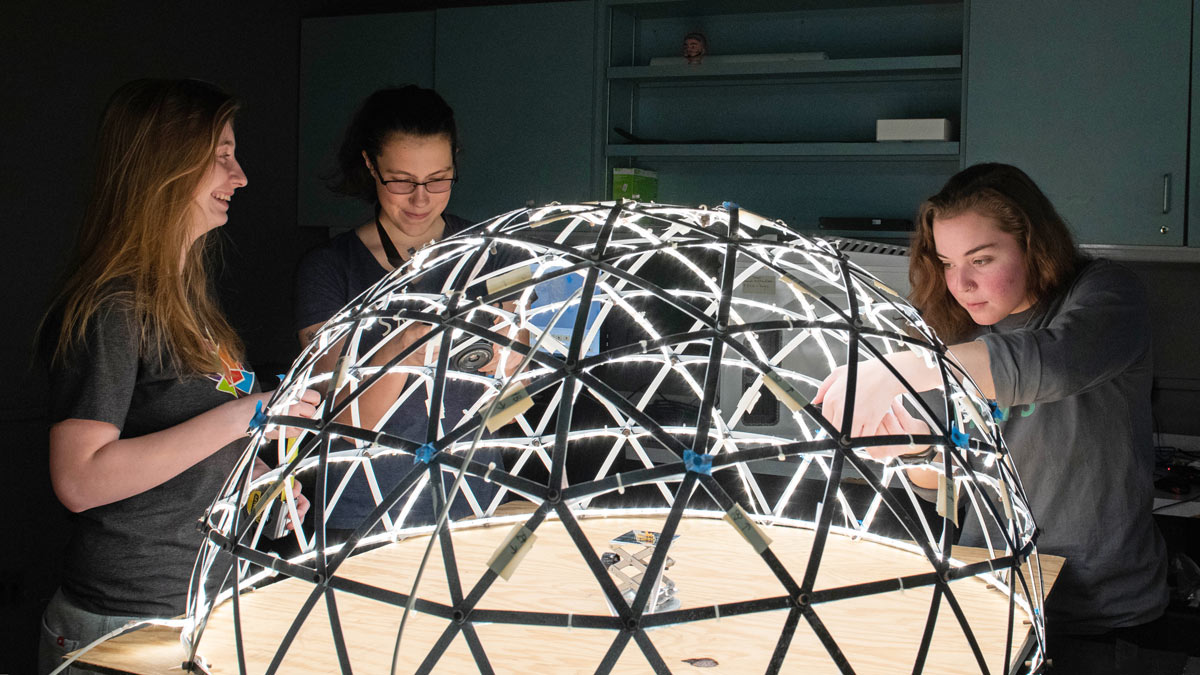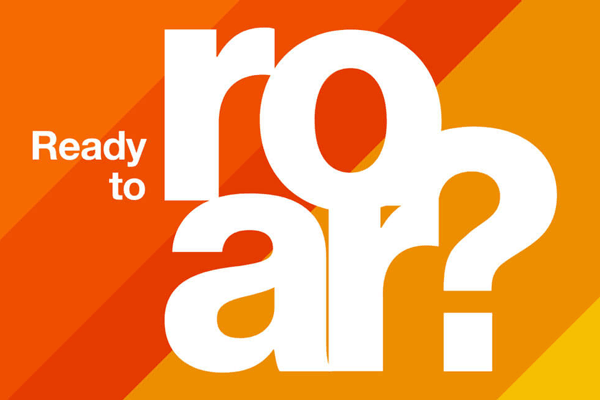Imaging Science Bachelor of Science Degree

Imaging Science
Bachelor of Science Degree
- RIT /
- Rochester Institute of Technology /
- Academics /
- Imaging Science BS
RIT’s imaging science BS combines physics, math, computer science, and engineering to develop cutting-edge imaging systems for satellites, drones, AR/VR, and more.
Overview for Imaging Science BS
Why Study RIT's Imaging Science BS Degree
Project Based Learning: Freshman Imaging Project, where you explore concepts in physics, mathematics, and computer science and experience the creation of a system to address a contemporary technological need.
Research Opportunities: Active research laboratories focus on remote sensing, human visual systems, multi-wavelength astronomy, computer and machine vision, cultural heritage imaging, and optics and photonics.
Strong Career Paths: Recent graduates employed at L3Harris, GoPro, Dolby, Facebook Reality Labs, Lockheed Martin, Boeing, Integrated Defense and Security Solution Holdings Inc., EagleView Technologies, and Planetary Resources, Inc.
STEM-OPT Visa Eligible: The STEM Optional Practical Training (OPT) program allows full-time, on-campus international students on an F-1 student visa to stay and work in the U.S. for up to three years after graduation.
What is Imaging Science?
Imaging science is the study of the science, computing, and engineering theories behind the technology that goes into creating images, the integration of this technology into imaging systems, and the application of those systems to gather information and solve scientific problems. Imaging science is used to design and develop cutting-edge imaging systems, such as portable eye trackers, virtual reality devices, satellite systems, digital cameras, or anything that involves recording, processing, displaying, or analyzing image data.
RIT’s Imaging Science BS
Augmented and virtual reality. Drones. Satellite imaging. Artificial intelligence and computer vision. Advanced security systems. This is imaging science.
RIT’s imaging science degree is an extraordinary major that combines physics, math, computer science, and engineering to create fully functioning imaging systems, which are used in areas such as:
- Scientific research and discovery
- Satellite imaging
- Filmmaking
- Search and rescue
- National security
- Land surveying
- AR/VR
With hands-on experience in cutting-edge labs and through course projects on day one, you'll be prepared for a career in imaging science with in-depth course work, such as:
- Imaging
- Optics
- Image processing
- Computer vision
- Imaging detectors
Imaging Science Classes
The bachelor's in imaging science includes the study of:
- the physical observables associated with the subject of an image, such as reflected or emitted electromagnetic radiation;
- how those observables are captured by devices using optics and detectors such as satellites, digital cameras, medical imaging devices, and astronomical observatories;
- how the captured observables are processed using computers and specialized software;
- how processed signals are converted into images displayed on paper and electronic devices, and perceived by humans; and
- how image quality is assessed and scientific information is extracted.
Adding a minor in a complementary area of study allows you to tailor the imaging science BS degree to your career goals, deepening your expertise in core imaging science concepts while broadening your skill set for a career in this innovative field. These minors enhance the imaging science degree:
- Applied Statistics
- Computer Science
- Environmental Science
- Geographic Information Systems
- Mathematics
- Mechanical Engineering
- Physics
Hands-On Experience to Gain Real World Skills
While enrolled in the imaging science degree, you will gain invaluable hands-on experience in a variety of ways:
- The imaging science degree begins with Freshman Imaging Project, a year-long project-based class in which you’ll learn about imaging science while designing and implementing a novel imaging system.
- As you progress in course work, both theoretical studies and practical applications of technologies are reinforced through hands-on laboratory experiments.
- The curriculum culminates with Imaging Science Senior Project I and II, a two-semester, two-course independent research project conducted by you under the guidance of faculty from the Chester F. Carlson Center for Imaging Science.
- You’ll examine a problem in one of several imaging applications such as remote sensing, astronomy, computer vision, manuscript imaging and enhancement, optics, color science, image quality, or visual perception.
- While enrolled in the imaging science major you are also encouraged to complete cooperative education and internship experiences. Learn more about science co-ops.
Furthering Your Education in Imaging Science
Combined Accelerated Bachelor's/Master's Degrees
Today’s careers require advanced degrees grounded in real-world experience. RIT’s Combined Accelerated Bachelor’s/Master’s Degrees enable you to earn both a bachelor’s and a master’s degree in as little as five years of study, all while gaining the valuable hands-on experience that comes from co-ops, internships, research, study abroad, and more.
- Imaging Science BS/Sustainable Systems MS: In this combined accelerated dual degree, you’ll merge a strong foundation in imaging science with a systems-level understanding of sustainability. Through course work and research, you’ll learn to use imaging technologies like remote sensing and satellite imagery to collect and interpret data critical to addressing environmental challenges in the sustainability space. Whether tracking climate change, monitoring natural resources, supporting sustainable infrastructure, curbing food waste at farm to production scales, you’ll be prepared to apply advanced imaging solutions to some of the world’s most pressing sustainability issues.
- +1 MBA: Students who enroll in a qualifying undergraduate degree have the opportunity to add an MBA to their bachelor’s degree after their first year of study, depending on their program. Learn how the +1 MBA can accelerate your learning and position you for success.
-
Join Us for Accepted Student Open House
Visit campus on March 28 or April 11 to meet faculty, tour campus, and ask your questions.
-
Apply for Fall 2026
First-year students can apply for Early Decision II by Jan. 1 to get an admissions and financial aid assessment by mid-January.
Careers and Cooperative Education
Typical Job Titles
| Imaging Scientist | Signal and Image Processing Engineer | Modeling and Simulation Analyst |
| Imaging Engineer/Color Scientist | Camera Systems Engineer | Sensor Engineer |
| AR/VR Researcher | Unmanned Aerial Vehicle (drone) Engineer | Satellite Imaging Scientist |
| Camera Hardware Engineer |
Industries
-
Research
-
Environmental Services
-
Scientific and Technical Consulting
-
Aerospace
-
Defense
-
Computer and Network Security
Cooperative Education
What’s different about an RIT education? It’s the career experience you gain by completing cooperative education and internships with top companies in every single industry. You’ll earn more than a degree. You’ll gain real-world career experience that sets you apart. It’s exposure–early and often–to a variety of professional work environments, career paths, and industries.
Co-ops and internships take your knowledge and turn it into know-how. Science co-ops include a range of hands-on experiences, from co-ops and internships and work in labs to undergraduate research and clinical experience in health care settings. These opportunities provide the hands-on experience that enables you to apply your scientific, math, and health care knowledge in professional settings while you make valuable connections between classwork and real-world applications.
In the imaging science degree, co-op is optional but strongly encouraged. Imaging science students gain career experience in a range of industries, including aviation, aerospace, environmental services, medical imaging, national research labs, and more. A sampling of companies that seek out RIT’s imaging science students for co-ops and full-time employment include Adobe, Amazon, Apple, Boeing, Google, L3 Harris, Lockheed Martin, Microsoft, NASA, National Geospatial Intelligence Agency, Naval Undersea Warfare Center, Sandia National Labs, and more.
Featured Work and Profiles
-
From Summer Intern to Imaging Scientist at Imatest, LLC
The decision to change majors led Meg Borek ‘22 to an internship that developed into a full-time position with Imatest, LLC.
Read More about From Summer Intern to Imaging Scientist at Imatest, LLC -
A Summer of Augmented Reality and 3D Software Experience
During his summer internship, RIT imaging science student, Mason Wahlers, gained valuable corporate experience while using augmented reality in the Emerging Technologies group at Corning, Inc.
Read More about A Summer of Augmented Reality and 3D Software Experience -
Assessing the Quality of Reconnaissance Images at Collins Aerospace
RIT imaging science student, Zoë Lalena, gained valuable experience assessing reconnaissance images while improving her coding skills during a summer internship at Collins Aerospace.
Read More about Assessing the Quality of Reconnaissance Images at Collins Aerospace -
Developing Algorithms for Collecting and Processing Satellite Imagery
As a research assistant, Gabriel Peters develops algorithms to collect, organize, and process image data from Landsat satellites in the Digital Imaging and Remote Sensing Laboratory at RIT.
Read More about Developing Algorithms for Collecting and Processing Satellite Imagery -
Imaging Science Degree Applied to a Growing List of Industries
Imergen Rosario, an RIT Imaging Science student, added cosmetics to the growing list of industries she has applied her degree to, which also includes remote sensing and psychophysics.
Read More about Imaging Science Degree Applied to a Growing List of Industries -
RIT Imaging Science: One Major, Countless Careers
Students graduating from the RIT Imaging Science program describe the unique major, research opportunities available and diverse careers after graduation.
Read More about RIT Imaging Science: One Major, Countless Careers
Curriculum for 2025-2026 for Imaging Science BS
Current Students: See Curriculum Requirements
Admissions and Financial Aid
This program is STEM designated when studying on campus and full time.
First-Year Admission
First-year applicants are expected to demonstrate a strong academic background that includes:
- 4 years of English
- 3 years of social studies and/or history
- 4 years of mathematics is required and must include algebra, geometry, algebra 2/trigonometry, and pre-calculus. Calculus is preferred.
- 2-3 years of science is required and must include chemistry or physics; both are recommended.
Transfer Admission
Transfer applicants should meet these minimum degree-specific requirements:
- A minimum of precalculus is required. Calculus is preferred.
- Chemistry or physics is required.
Financial Aid and Scholarships
100% of all incoming first-year and transfer students receive aid.
RIT’s personalized and comprehensive financial aid program includes scholarships, grants, loans, and campus employment programs. When all these are put to work, your actual cost may be much lower than the published estimated cost of attendance.
Learn more about financial aid and scholarships
Accreditation
Research
Our faculty, staff, and students conduct research sponsored by both industry and the government. Dedicated research support ensures that you are exposed to the latest developments in the rapidly expanding field of imaging science.
Undergraduate research experiences are available through the Chester F. Carlson Center for Imaging Science and are highly encouraged. The Carlson Center focuses its research initiatives on astronomy, cultural heritage imaging, detectors and imaging systems, human and computer vision, remote sensing, nano-imaging, magnetic resonance, and optical imaging. Research opportunities enable you to immerse yourself in these dynamic areas of study as you engage in the real-world application of the information you are studying in the classroom. Explore the variety of imaging science undergraduate research happening at RIT.
Related News
-
December 2, 2025

Students go Into the ROC to connect with their community
Through Into the ROC, a program that introduced nearly 8,500 RIT community members to the region since 2016, students have explored, volunteered, and built lasting community ties.
-
November 19, 2025

RIT innovation helps illuminate lost history
The goal of libraries, museums, and archives around the world is to safeguard historical documents, but some objects can deteriorate with time. RIT’s Cultural Heritage Imaging (CHI) lab is using funding from the National Endowment for the Humanities to develop a relatively low-cost system that makes cultural heritage imaging methods more accessible.
-
April 22, 2025

Virtually endless possibilities: RIT researchers push boundaries with immersive technologies
RIT researchers are pushing the boundaries with immersive technologies, including augmented reality (AR), virtual reality (VR), extended reality (XR), and mixed reality (MR).
Contact
- James Ferwerda
- Associate Professor
- Chester F. Carlson Center for Imaging Science
- College of Science
- james.ferwerda@rit.edu
Chester F. Carlson Center for Imaging Science





















